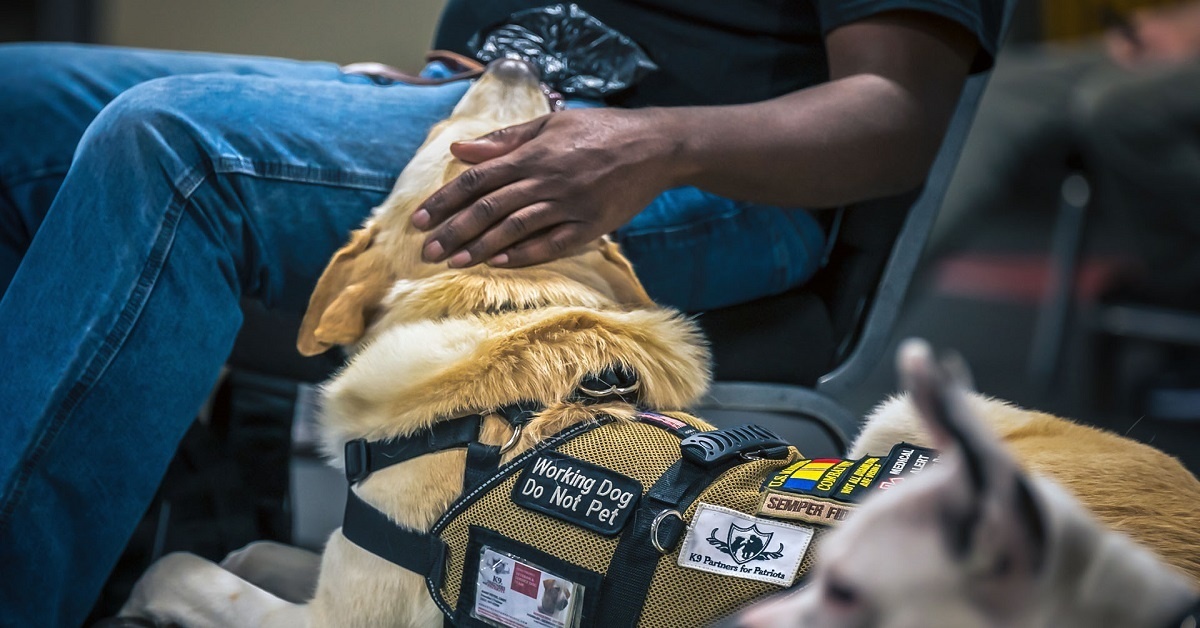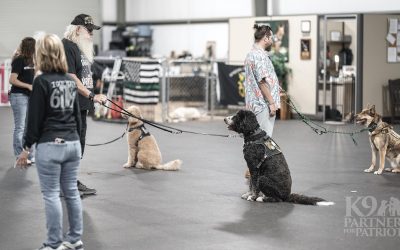18.2 million military veterans currently live in the U.S. Of those, one in three have some sort of substantial post-combat mental health challenge. And approximately 20% suffer from Post Traumatic Stress Disorder (PTSD).
Invisible injuries like PTSD, as well as Traumatic Brain Injury (TBI) and Military Sexual Trauma (MST), can have a devastating impact on a vet’s family relationships, work, sleep, mental state, and ability to function.
According to the Department of Defense, 20 military vets take their own life every day. Are you comfortable with those numbers? K9 Partners for Patriots in Brooksville, FL, definitely is not. This nonprofit coterie of caring professionals and volunteers is determined to end the plague of veteran suicide once and for all. They match painstakingly screened service dogs with vets who’ve been medically diagnosed with PTSD, TBI or MST, and then work with these vets on training the dog for their needs. While this effort is underway, K9P4P’s staff are there to provide the vets with a second family – offering moral support, group and individual therapy, and situation rooms that enable these vets to practice coping skills in a no-pressure, accepting environment. All of this is provided at NO cost to the vet.
Mary Peter, a certified master dog trainer and founder of K9 Partners for Patriots, shares a dramatic example of the life-saving and life-affirming value of the vet-service dog partnership: “We had a veteran come to us seeking help after several suicide attempts. He brought his personal dog, a rescue, for us to evaluate for suitability as a service dog. He felt that this dog had rescued him as much as he had rescued her. His dog passed our temperament evaluation and the two were placed into one of our 6-month service dog training classes. Their bond grew stronger and stronger.
“Near the end of the 6 months of training, his dog started acting strangely in class. It appeared that she was having a seizure. Our veteran began to panic, so we had him sit down with the dog so we could evaluate them both. His dog was definitely off, which put our veteran in a full-blown panic attack, with his eyes rolling back in his head.
“His dog, more concerned about him than herself, approached him and barked softly to get his attention. It didn’t work. She placed herself between his legs and barked again. Still nothing. She kept trying to do her job and refocus him but it wasn’t working. We watched what seemed to be her analyzing the situation and then she jumped with both front legs and bounced on his chest with a very loud bark. Our veteran was then brought back to the present, wrapped his arms around his dog’s neck, and both stayed that way until he could calm down.
“We took them to the veterinarian, who confirmed the seizure-like symptoms, but both veteran and service dog were able to go home and continue with their training and subsequently graduated. Sadly, his dog had to be pulled from the program due to her seizures and passed away, unable to come out of one.
“Because of what our veteran learned here with his service dog, we were able to match him with another dog to restart training. His first dog saved his life and gave him the will to try another dog … instead of another suicide attempt.
“Our veteran did graduate with his second dog and is now flying all over to visit family. He moved to Ohio and just came back for his one-year recertification. He’s doing great.”
Mary added, “The average cost for us to put a veteran and K9 through the 6-month training program is $15,000. However, in this case, the service dog required extensive veterinary care. Thankfully, due to the relationships, we’ve developed with supporting partners, we were able to cover those bills to ease the burden on the veteran.”
Once a screened service dog chooses its human, it is trained to perform the following tasks:
• The dog acts as a protective buffer between the vet and other people, easing the vet’s hypervigilance and anxiety among crowds.
• The dog wakes the vet from upsetting dreams or night terrors. Sleep is the ultimate restorative, but sleep interrupted by nightmares can exacerbate daytime mood swings and stress levels. Furthermore, it makes the act of falling asleep stressful in itself.
• The dog smells changes in adrenaline levels, recognizing and interrupting escalations of anxiety or anger.
• The dog puts its weight on the vet during panic attacks to alert, distract and soothe the vet; you saw this benefit in the anecdote above.
• The dog lets the vet know when someone is approaching from behind; this can be a panic trigger for many vets.
• The dog provides an excuse to leave during tense social situations; for example, by nudging. Such situations can develop after clueless, unwarranted comments from strangers about the vet’s service dog or invisible injury.
• With its solicitous support, the dog reteaches emotions like love and affection.
Benefits that a trained service dog provides to a vet:
• Ability to recognize and better manage symptoms and problem behaviors
• Greater independence, thanks to the vet’s increased confidence in his/her coping skills
• Restored sense of purpose
• Reduced anxiety, stress, and hypervigilance (have you ever heard a strange noise and thought, if the dog isn’t worried, I’m not worried?)
• Decreased reliance on prescription drugs or alcohol, as the dog’s gentle ministrations are naturally calming
• Strengthened relationships; with the dog’s help, potential arguments can be de-escalated into discussions
• Improved sleep
While all equipment and training provided to K9 Partners for Patriots’ service dog teams are at NO COST to the veteran and will always be so, it is an expensive endeavor. Please visit k9partnersforpatriots.com/donate/ and consider donating your time or money to help support their life-saving work. The Double the Impact! An anonymous donor’s $100K Challenge is still in effect and will double your donation amount until the $100,000 goal is reached.
Article reposted with permission from Tampa Bay Times.





